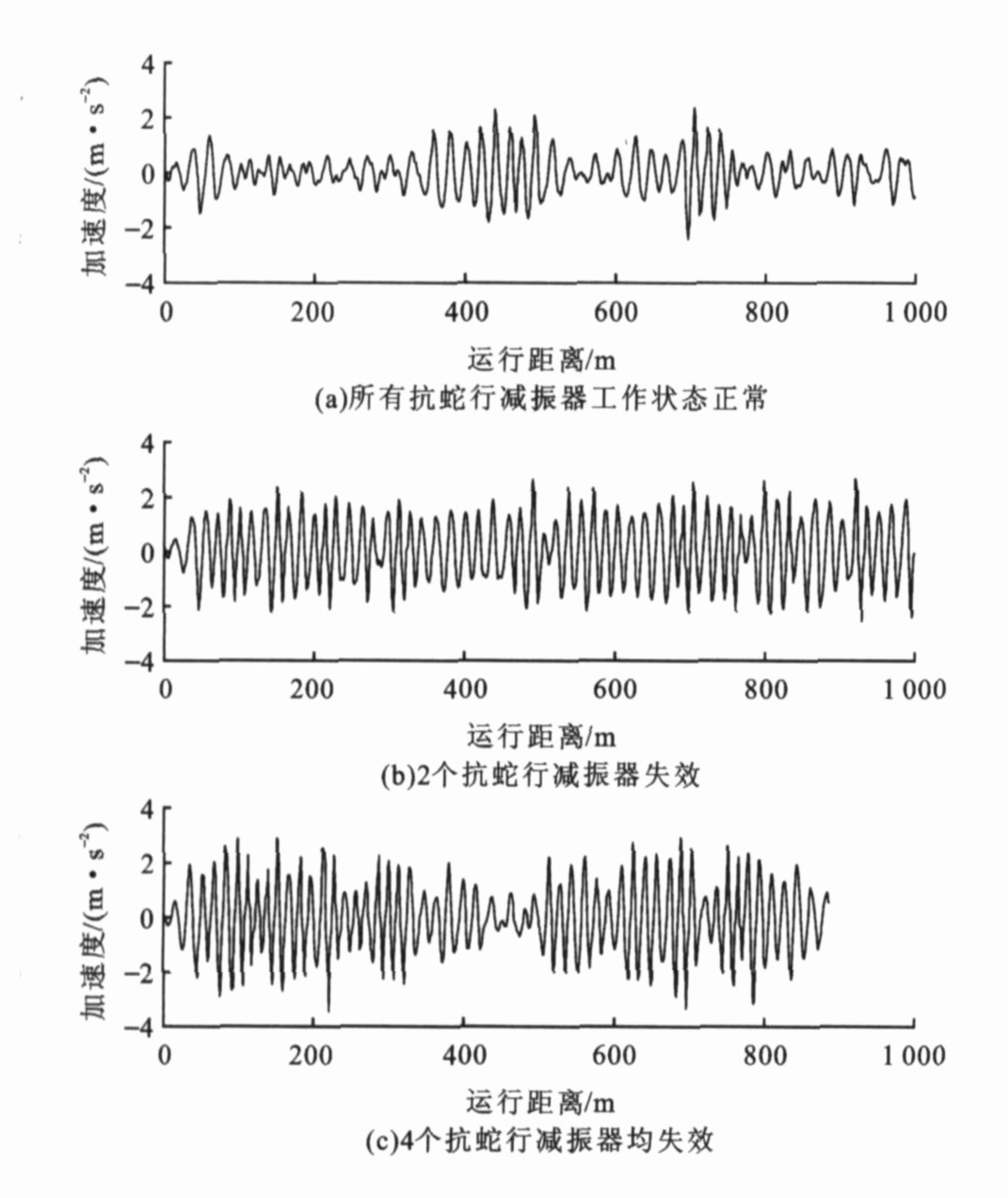Effect of yaw dampers on locomotive riding comfortability
-
摘要: 为了减小提速机车在提速区段异常振动, 提高机车运行平稳性, 以抗蛇行减振器为研究对象, 运用机车车辆-轨道耦合动力学理论, 以机车运行平稳性指标为依据, 从机车抗蛇行减振器的工作状态、卸荷速度、结构阻尼参数等入手, 研究了抗蛇行减振器与机车运行平稳性的关系。仿真计算与分析结果表明: 抗蛇行减振器的工作状态对机车运行平稳性有较大的影响, 必须严格确保所有减振器的工作状态均正常; 取适当的卸荷速度可以达到提高乘车舒适性的目的; 抗蛇行减振器的结构阻尼参数越大, 对提高机车的平稳性越有利。Abstract: In order to effectively control the severe sway and improve the riding comfortability for speed-raised locomotive, the effects of the damping parameters, unloaded speeds and working conditions of dampers on locomotive comfortability were analyzed by vehicle and track coupling dynamics.Analysis result shows that the working conditions of dampers have much effect on the running quality of locomotive, so it must be ensured that all of dampers are in work when locomotive runs on railway; it can improve locomotive riding performance to choose proper unloaded velocities of dampers; the bigger the damping values of all dampers are, the more comfortable locomotive is.
-
Key words:
- locomotive engineering /
- damper /
- parameter optimization /
- comfortability /
- dynamics
-
表 1 工作状态对舒适性的影响
Table 1. Effects of work conditions on lateral comfortability
速度/ (km·h-1) 指标 工作状态 均正常 1个失效 2个失效 3个失效 全失效 140 加速度最大值/ (m·s-2) 2.0 2.2 2.4 2.5 2.7 平稳性指标 3.05 3.18 3.27 3.48 3.59 150 加速度最大值/ (m·s-2) 2.3 2.4 2.6 2.8 2.9 平稳性指标 3.23 3.28 3.39 3.57 3.68 160 加速度最大值/ (m·s-2) 2.4 2.5 2.6 2.9 3.4 平稳性指标 3.28 3.39 3.97 4.21 4.56 表 2 卸荷速度对舒适性的影响
Table 2. Effects of unloaded speeds on locomotive comfortability
速度/ (km·h-1) 指标 卸荷速度/ (m·s-1) 0.01 0.02 0.03 0.04 0.05 0.06 0.07 0.08 140 加速度最大值/ (m·s-2) 2.0 1.5 1.4 1.5 1.5 1.5 1.5 1.5 平稳性指标 3.05 2.68 2.67 2.69 2.68 2.69 2.69 2.69 150 加速度最大值/ (m·s-2) 2.3 1.6 1.6 1.7 1.6 1.6 1.6 1.7 平稳性指标 3.23 2.71 2.75 2.76 2.76 2.78 2.78 2.78 160 加速度最大值/ (m·s-2) 2.4 1.7 1.8 1.8 1.7 1.7 1.8 1.9 平稳性指标 3.28 2.76 2.80 2.83 2.82 2.82 2.82 2.83 -
[1] 魏春阳, 张健. 东风11型机车在准高速速度区段横向性能的改进[J]. 内燃机车, 2002, 37(10): 36-38. doi: 10.3969/j.issn.1003-1820.2002.10.016Wei Chun-yang, Zhang Jian. Improvement on lateral performance of DF11 locomotive at quasi-high speed[J]. Diesel Locomotives, 2002, 37(10): 36-38. (in Chinese) doi: 10.3969/j.issn.1003-1820.2002.10.016 [2] 翟婉明, 王开云, 孟宏, 等. 改善SS7E型电力机车整车动力学性能参数优化[R]. 成都: 西南交通大学, 2003. [3] 王开云, 孟宏. SS7E型电力机车横向晃动问题的理论分析[J]. 机车电传动, 2004, 45(6): 45-48. doi: 10.3969/j.issn.1000-128X.2004.06.014Wang Kai-yun, Meng Hong. Theoretical analysis on transverse sway of SS7E locomotive[J]. Electric Drive for Locomotive, 2004, 45(6): 45-48. (in Chinese) doi: 10.3969/j.issn.1000-128X.2004.06.014 [4] 翟婉明. 车辆-轨道耦合动力学[M]. 北京: 中国铁道出版社, 2002. [5] Zhai Wan-ming, Sun Xiang. A detailed model for investigating vertical interactionsbetween railway vehicle and track[J]. Vehicle System Dynamics, 1994, 23(Suppl): 603-615. [6] 王开云, 翟婉明, 刘建新, 等. 山区铁路小半径曲线强化轨道动力性能[J]. 交通运输工程学报, 2005, 5(4): 15-19. doi: 10.3321/j.issn:1671-1637.2005.04.004Wang Kai-yun, Zhai Wan-ming, Liu Jian-xin, et al. Dynamic performances of small-radius curved track for mountain strengthened railway[J]. Journal of Traffic and Transportation Engineering, 2005, 5(4): 15-19. (in Chinese) doi: 10.3321/j.issn:1671-1637.2005.04.004 [7] 王开云, 翟婉明. 车辆-轨道耦合动力学仿真软件TTISIM及其试验验证[J]. 中国铁道科学, 2004, 25(6): 48-53. doi: 10.3321/j.issn:1001-4632.2004.06.009Wang Kai-yun, Zhai Wan-ming. TTISIM software for vehicle-track coupling dynamics simulation and its verification[J]. China Railway Science, 2004, 25(6): 48-53. (in Chinese) doi: 10.3321/j.issn:1001-4632.2004.06.009 [8] TB/T2360-93, 铁道机车动力学性能试验鉴定方法及评定标准[S]. [9] GB 5599-85, 铁道车辆动力学性能评定和试验鉴定规范[S]. [10] 罗云, 陈康, 金鼎昌. 减振器卸荷特性对2B0动力车动力学性能的影响[J]. 西南交通大学学报, 2004, 39(5): 648-652. doi: 10.3969/j.issn.0258-2724.2004.05.021Luo Yun, Chen Kang, Jin Ding-chang. Influence of damping characteristics of dampers on dynamic performances of four-axle power cars[J]. Journal of Southwest Jiaotong University, 2004, 39(5): 648-652. (in Chinese) doi: 10.3969/j.issn.0258-2724.2004.05.021 [11] 刘建新, 王开云, 封全保, 等. 横向减振器对机车平稳性能的影响[J]. 交通运输工程学报, 2006, 6(3): 1-4. http://transport.chd.edu.cn/article/id/200603001Liu Jian-xin, Wang Kai-yun, Feng Quan-bao, et al. Influence of lateral damper on locomotive riding quality[J]. Journal of Traffic and Transportation Engineering, 2006, 6(3): 1-4. (in Chinese) http://transport.chd.edu.cn/article/id/200603001 -





 下载:
下载:



